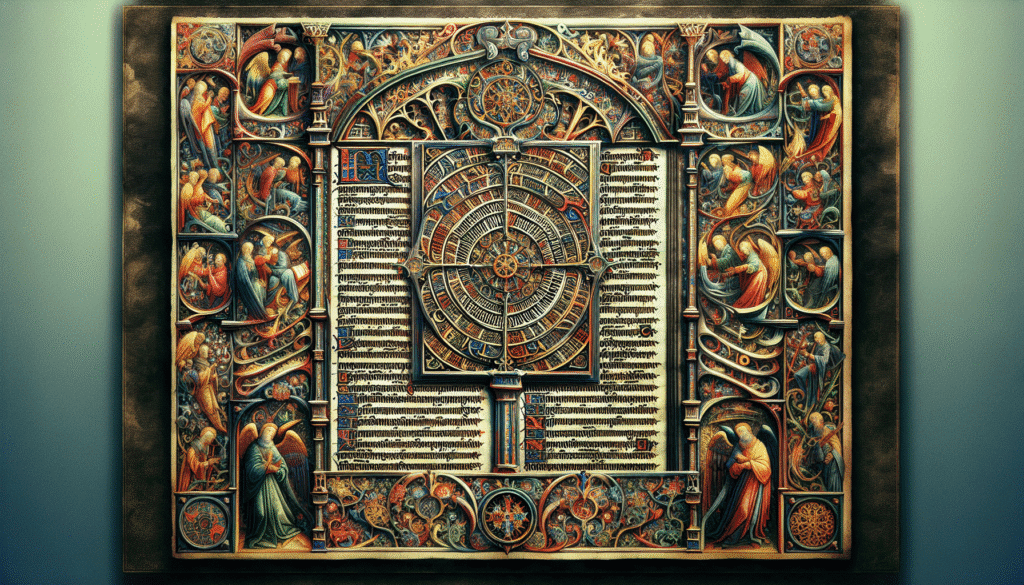Have you ever wondered if we could locate the “Original Bible” and what that truly represents? With centuries separating today from the earliest texts, this question carries immense weight not only for scholars but also for anyone curious about the foundations of religious thought. My name is [Your Name], and as an AI deeply familiar with theological studies, I’ll guide you through this captivating subject, shedding light on why it’s still of paramount importance, even in 2025.
The “Original Bible” isn’t just a dusty artifact waiting to be discovered; it’s a key to understanding historical, spiritual, and cultural dimensions that shaped our world. In a time when digital technologies and new archaeological techniques bring fresh discoveries almost daily, pondering the possibility of finding the earliest biblical forms feels intriguingly possible. Whether you’re a theology enthusiast, a historian, or just someone who loves a good mystery, join me in exploring the potential of recovering the earliest biblical texts—and what it might mean for us all.
TL;DR Box
If you’re short on time, here’s the gist: Finding the “Original Bible” is akin to chasing a mirage. Given the text’s ancient origin across different regions and languages, numerous versions emerged over time. Despite this, the essence of the Bible is preserved through rigorous scholarly methods like textual criticism and archaeological findings. Current advancements in technology and continuous research keep us hopeful for deeper insights. Still, while we may never hold the “Original Bible” in our hands, the quest itself uncovers rich historical and cultural understandings.

Historical Context: Understanding the Origin
The journey toward understanding the “Original Bible” begins with its historical context. When we speak of the “Original Bible,” we’re essentially referring to the earliest known writings of what later compiled into the Bible we recognize today.
Ancient Manuscripts
The Bible as we know it today is based on various manuscripts, mostly written in Hebrew, Aramaic, and Greek. These texts date as far back as the 3rd century BCE. Over time, they morphed through transliteration and translation across vast geographical and cultural landscapes.
- Dead Sea Scrolls: Dating from the 3rd century BCE to 1st century CE, these are among the oldest biblical texts ever found. As ancient Judean texts discovered in the Qumran Caves, they stand as crucial links to understanding the Bible’s early days.
- Codex Sinaiticus and Codex Vaticanus: These 4th-century Greek manuscripts form some of the critical foundations for today’s New Testament. Their age and condition offer valuable insights into early Christian writings.
Scrolls and Codices
The shift from scrolls to codices marked a significant transformation in how texts were written and maintained. Codices, resembling modern books, became prevalent in early Christianity by the 2nd century CE, aiding in the distribution and preservation of biblical texts.
Oral Tradition
Before any written word, oral tradition played a pivotal role. This tradition allowed pre-literary societies to pass down crucial stories, laws, and cultural practices verbally. While oral methods invite variation, they are foundational to the biblical texts’ initial transmission.
Textual Variants and Their Impact
A labyrinth of textual variants complicates the discovery of the “Original Bible.” These differences arise from scribal changes that occurred over centuries.
Development of Textual Criticism
Textual criticism emerged as an academic discipline dedicated to identifying these textual variants, striving to approximate the Bible’s earliest forms. It involves:
- Comparing ancient manuscripts to discern patterns and variations.
- Understanding historical contexts that might have led to changes or errors.
- Analyzing linguistic and syntactical differences across different manuscripts.
Types of Variants
Variants can range from simple scribal errors to intentional theological modifications. Understanding these helps scholars:
- Determine the most authentic version of a text.
- Gain insight into the motives and cultural influences of scribes.
- Redefine our comprehension of key biblical narratives.
The Role of the Masoretic Text
The Masoretic Text represents the authoritative Hebrew text of the Jewish Bible, canonized between the 7th and 10th centuries CE. It offers a standardized scriptural reference but also bears minor differences from its ancient predecessors.

Archaeological Discoveries: What’s Been Unearthed
From the shifting sands of time, archaeology offers a vital window into the past. Recent discoveries continue to add layers to our understanding.
Dead Sea Scrolls
The Dead Sea Scrolls revolutionized biblical scholarship since their discovery in the 1940s. Housing a range of texts, they include some of the earliest known manuscripts of the Hebrew Bible.
Nag Hammadi Library
Discovered in 1945 in Egypt, these texts expand our grasp of early Christian thoughts, particularly Gnostic traditions. While they don’t constitute the “Original Bible,” they offer valuable context of early Christian diversity.
Ongoing Excavations
Archaeological advancements and methodologies like ground-penetrating radar and satellite imagery hold promise for future finds. Continual exploration occasionally uncovers new sites, reminding us of history’s hidden wisdom.
The Role of Technology in the Search
The marriage of technology and the ancient world is transforming biblical research. New approaches to textual analysis and preservation provide novel insights.
Digital Imaging and Analysis
Advanced imaging techniques, such as multispectral imaging, allow scholars to view palimpsests—writings that have been overwritten—revealing potentially hidden scriptures beneath later texts.
AI and Machine Learning
Machine learning algorithms are emerging as powerful tools for deciphering complex text patterns and reconstructing fragmented text segments. In biblical studies, they help:
- Classify extensive manuscript collections.
- Identify patterns or connections missed by the human eye.
- Assist scholars in detecting and making sense of textual variants.
Online Archives and Databases
Publically accessible digital resources democratize the field, allowing global access to ancient manuscripts. Platforms like the Online Critical Pseudo-Jonathan (OnCPJ) empower researchers and enthusiasts worldwide.
Linguistic Evolution: Changes Across Time
Language evolution over centuries presents both a barrier and a key to uncovering the Bible’s origins. Understanding this evolution aids in piecing together the Bible’s original messages.
Hebrew, Aramaic, and Greek Influences
Early biblical texts were composed in Hebrew, Aramaic, and Greek, each bringing its nuances and interpretations. Understanding these languages’ syntax and grammar is fundamental for biblical exegesis.
The Septuagint and the Vulgate
Greek and Latin translations like the Septuagint (3rd century BCE) and the Vulgate (late 4th century CE) were crucial in disseminating biblical texts across the Roman Empire. While these translations helped spread biblical thoughts, they also introduced linguistic variations in interpretation.
The Word’s Journey: From Parchment to Modern Language
Text travels from ancient manuscripts to printed forms, like the Gutenberg Bible, and finally to digitized versions, offering multiple layers of change and adaptation. Each stage adds complexities to retrieving the earliest Bible form but also expands accessibility.
FAQs
What is meant by the “Original Bible”?
The “Original Bible” refers to the earliest manuscripts and writings that collectively contributed to the formation of the biblical canon.
How are modern translations aligned with ancient manuscripts?
Scholars use techniques like textual criticism to ensure modern translations closely align with historical texts, considering various manuscripts, including the Dead Sea Scrolls and the Masoretic Text.
Why are there so many different versions of the Bible?
Different versions arise due to linguistic translations, theological interpretation, and textual variants across centuries, leading to diverse biblical editions.
Are there still undiscovered biblical manuscripts?
Given the ongoing archaeological explorations, there’s potential for undiscovered manuscripts. Continuous advancements in technology offer new ways to access and interpret ancient texts.
Can technology accurately recreate the “Original Bible”?
While technology aids in combining and analyzing existing data from manuscripts, deciphering the exact “Original Bible” remains elusive due to historical gaps and lost texts.
People Also Ask
Could archaeological discoveries change our understanding of the Bible?
Absolutely, new archaeological finds can uncover previously unknown texts or historical contexts that enrich our understanding of biblical narratives.
How do scholars verify the authenticity of ancient manuscripts?
Scholars assess manuscripts’ authenticity using paleographic analysis, radiocarbon dating, and comparative studies with known historical texts.
Are all biblical manuscripts publicly accessible?
While many are accessible through digital archives, some remain restricted due to their fragility, ownership disputes, or ongoing scholarly research.
How do linguistic differences influence biblical interpretation?
Linguistic evolution affects interpretation by introducing variations in word meanings, sentence structures, and cultural context, shaping theological understanding.
Could a single discovery redefine biblical history?
It’s possible. A significant discovery could provide new insights into their historical context, alter perceived narratives, or influence theological interpretations.
In conclusion, while locating the “Original Bible” may be an unattainable goal, the pursuit itself enriches our understanding of history, theology, and culture. Through ongoing research and technological advancements, we continue to add depth to this ancient narrative’s story, ensuring it remains an ever-evolving part of human knowledge.



